Abstract
1. The pharmacological characteristics of adrenoceptors at different temperatures were assessed on the basis of the effects of various alpha- and beta-adrenoceptor agonists and antagonists on electrically-driven left atria and spontaneously-beating pairs of atria from rats. 2. Phenoxybenzamine (Pbz) potentiated inotropic responses of left atria to noradrenaline (NA) at 31 degrees C, produced significantly less potentiation at 24 degrees C and inhibited responses at 17 degrees C; it had little effect on responses to CaCl2. Both Pbz and phentolamine inhibited responses to phenylephrine more effectively at 17 than at 31 degrees C. N-cyclohexylmethyl-N-ethyl-beta-chloroethylamine hydrochloride (GD-131), a haloalkylamine with negligible alpha-adrenoceptor blocking activity, caused only potentiation of responses to NA at 17 degrees C. 3. The presence of phentolamine during incubation with Pbz eliminated block of responses to NA and revealed a potentiation that was equivalent at all three temperatures tested. Phentolamine did not alter the block of responses to 5-hydroxytryptamine by Pbz. Protection of alpha-adrenoceptors by phentolamine during exposure to [3H]-Pbz significantly decreased the amount of label bound to the myocardium at 17 degrees C, but did not alter binding at 31 degrees C. 4. Inhibition of responses to NA by propranolol decreased with temperature, and the magnitude of the change increased with the concentration of propranolol. Compared to 31 degrees C, the effect of the highest concentration of propranolol. (4.0 micronM) was significantly decreased at 24 degrees C, and the effects of all except the lowest concentration (0.04 micronM) were significantly decreased at 17 degrees C. 5. The potency of isoprenaline decreased and that of phenylephrine increased at low temperatures, and their potency ratio was much lower at 17 than at 31 degrees C for both the inotropic and chronotropic responses of spontaneously-beating atria. However, the ratio was unaffected by temperature in electrically-driven left atria. A similar difference between spontaneously-beating and driven preparations is apparent in the data of other workers, but its basis is not clear. 6. Atria from rats pretreated with 6-hydroxydopamine (6-OHDA) were sensitized to the effects of NA, and there was no increase in alpha-adrenoceptor properties at low temperatures. Little alpha-adrenoceptor activity could be demonstrated in chemically denervated atria at any temperature, 6-OHDA pretreatment did not alter the binding of [3H]-Pbz at 31 degrees C, but decreased it significantly at 17 degrees C. Pretreatment with reserpine caused some sensitization, but not significantly after the characteristics of the adrenoceptors or their responses to temperature. 7. It is concluded that the adrenoceptors of atria are affected by temperature in much the same way as those of frog hearts, although the transition from beta- to alpha-adrenoceptor properties may begin at a slightly higher temperature...
Full text
PDF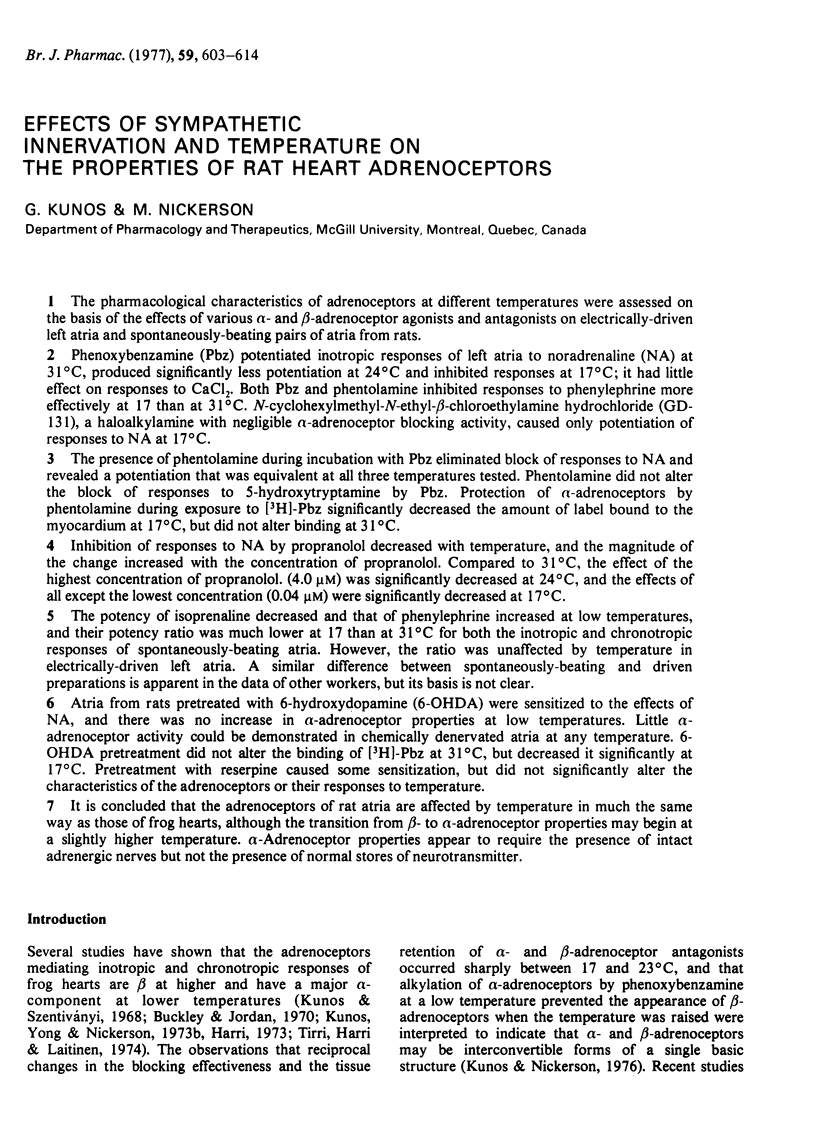
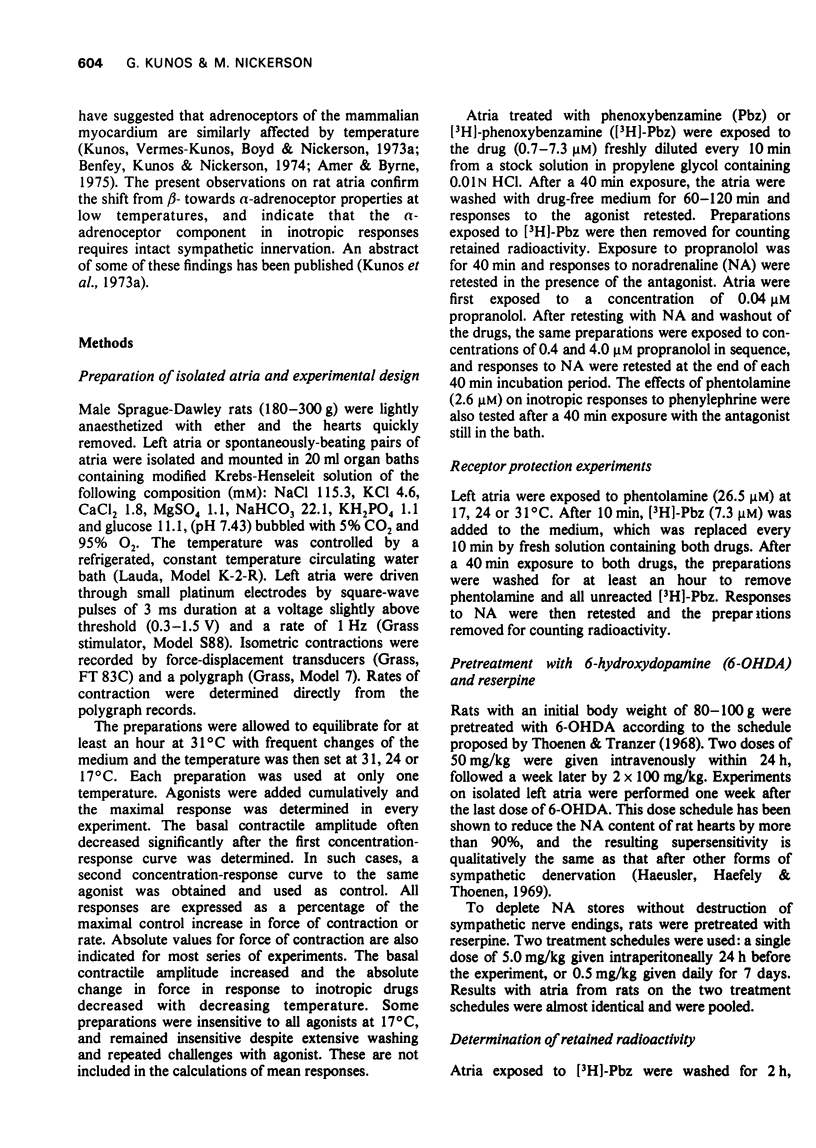
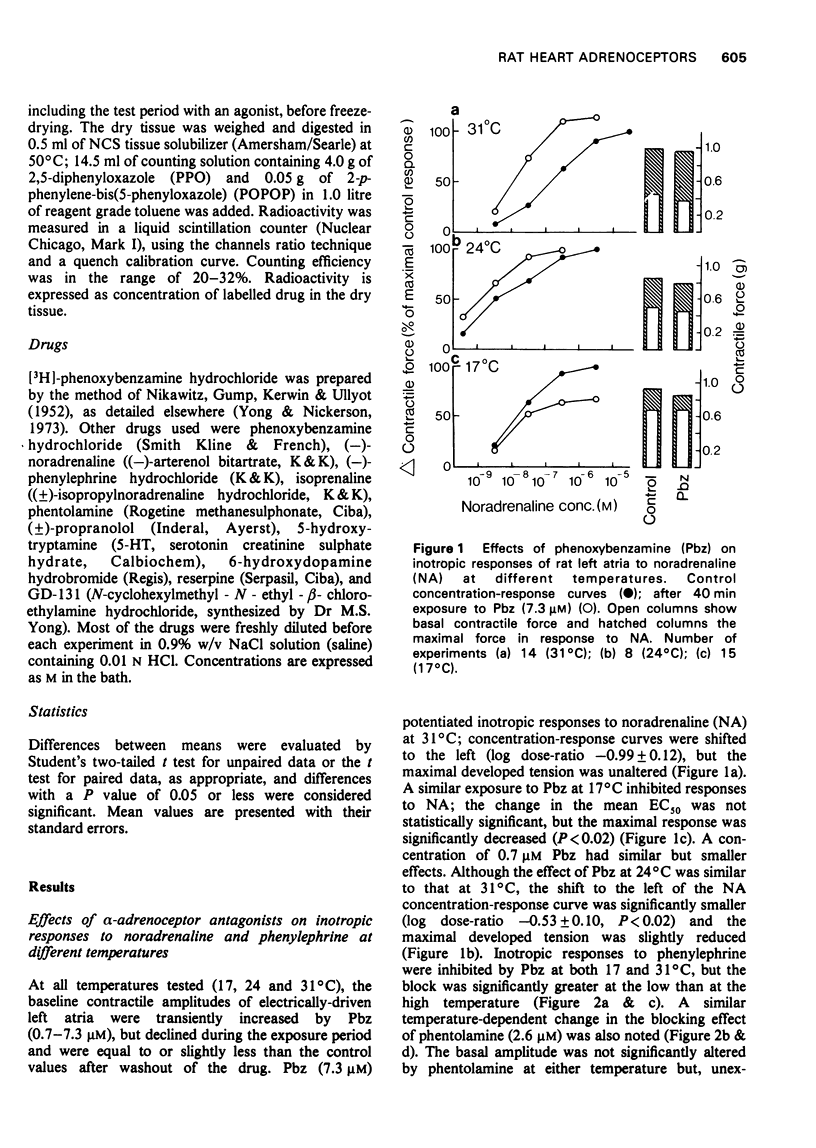
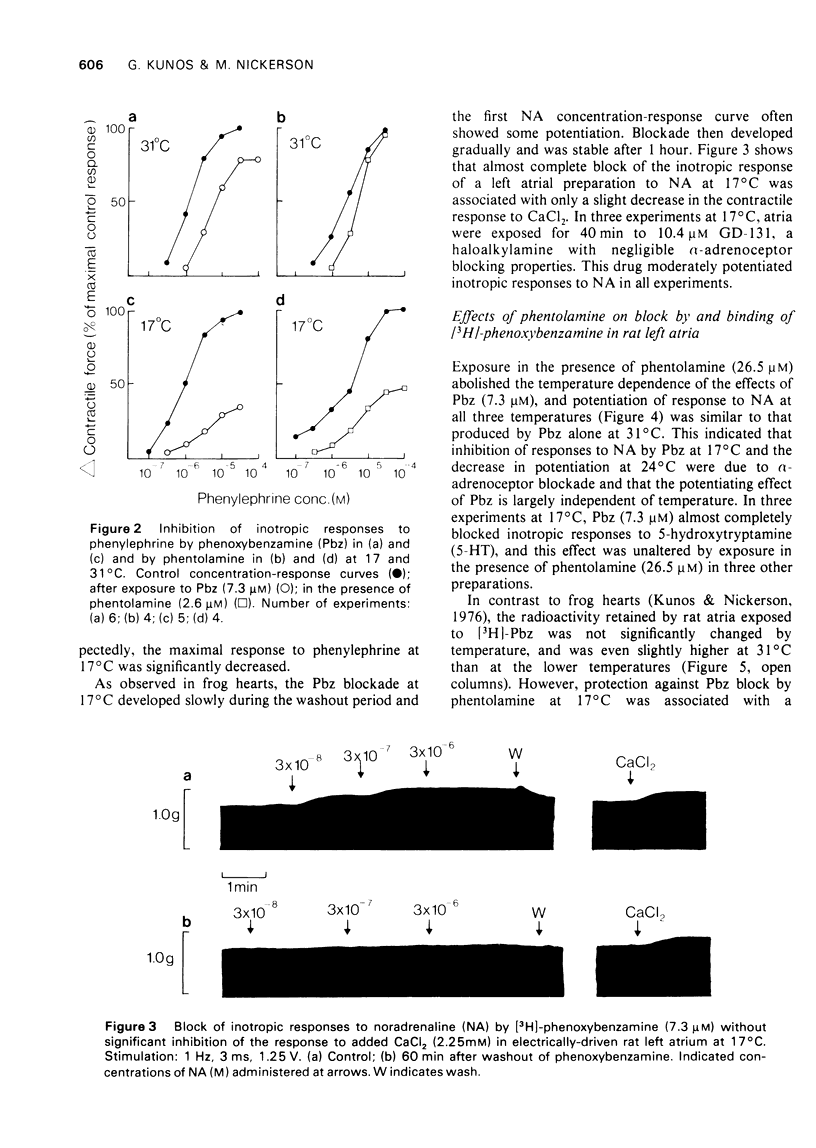
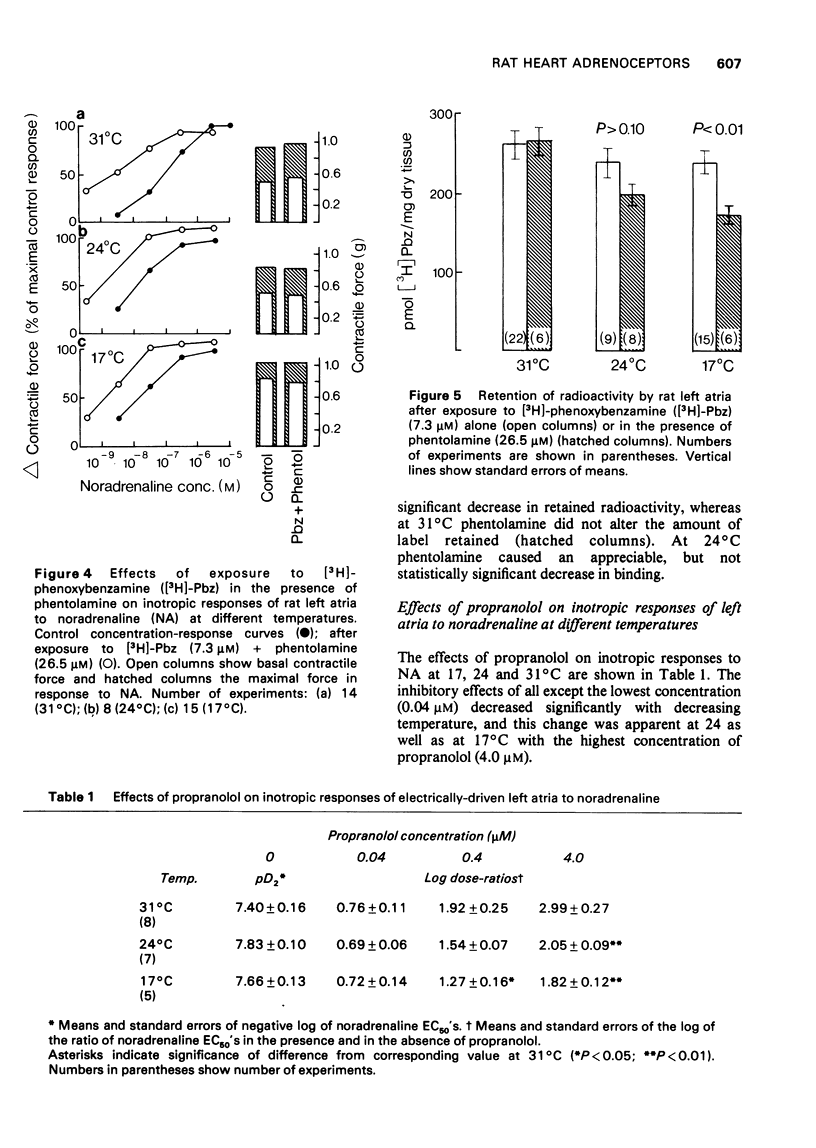
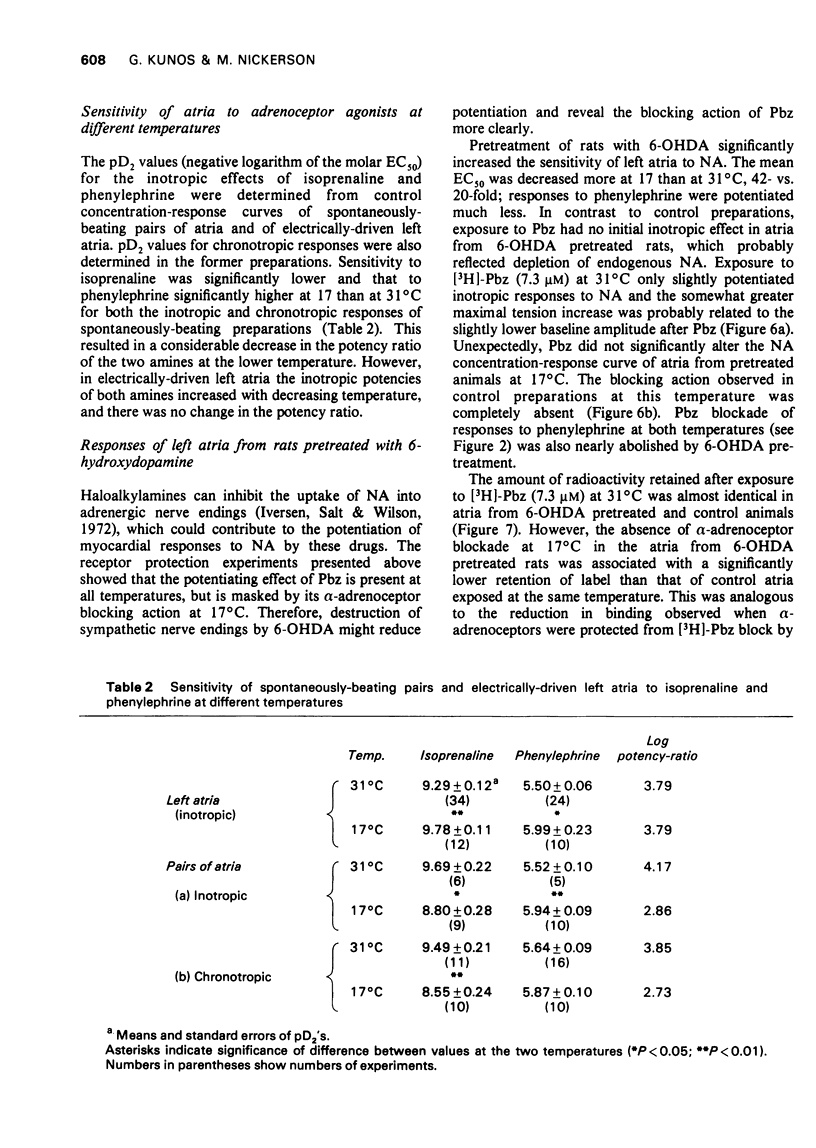
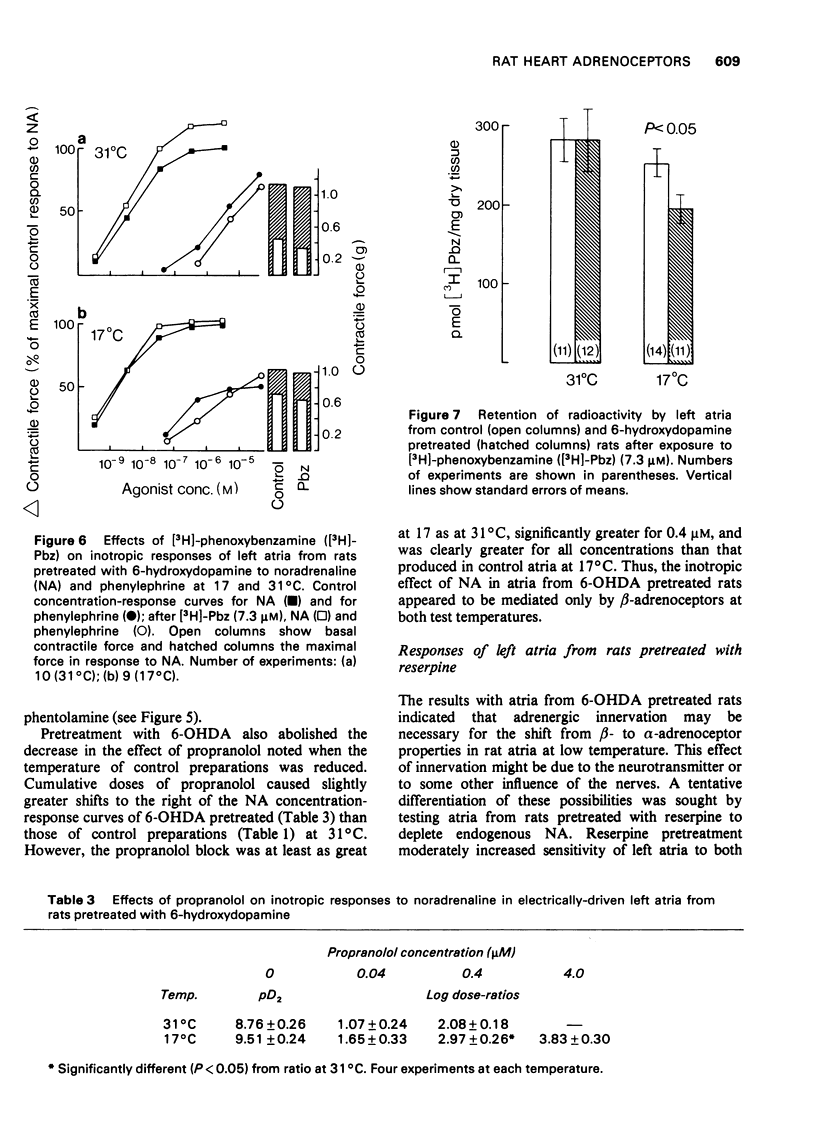
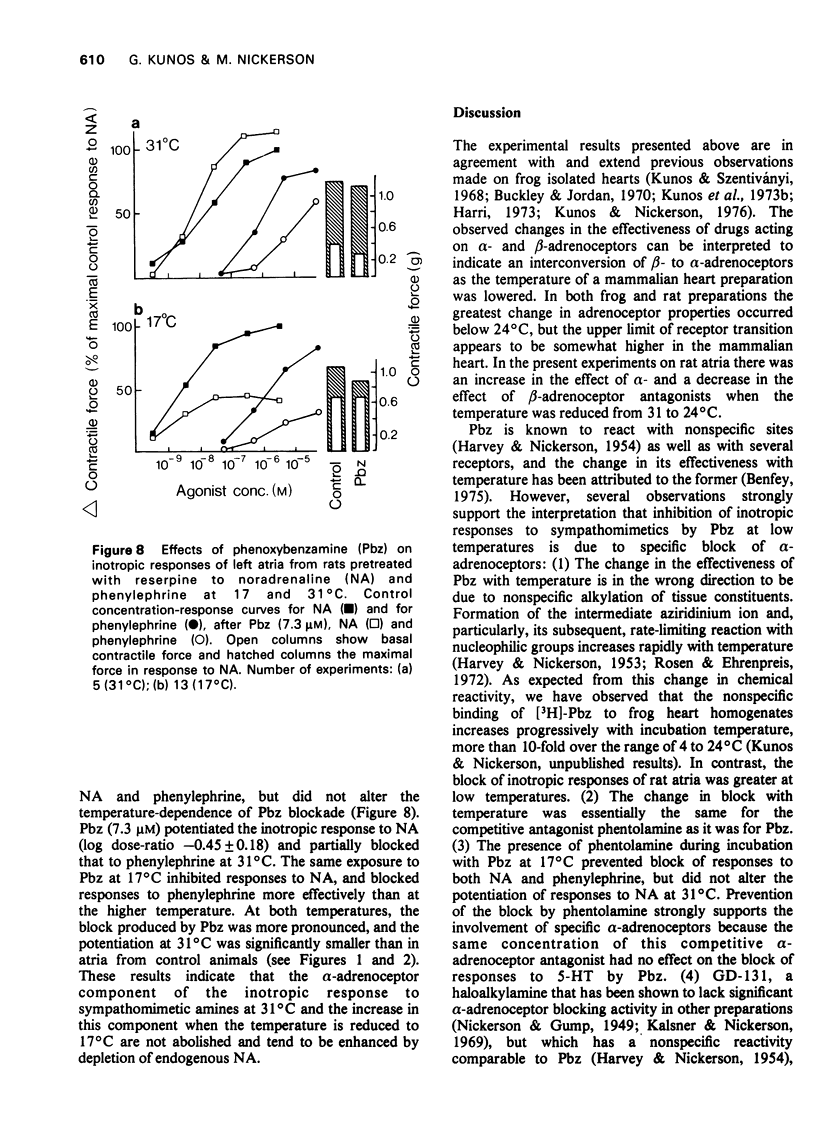

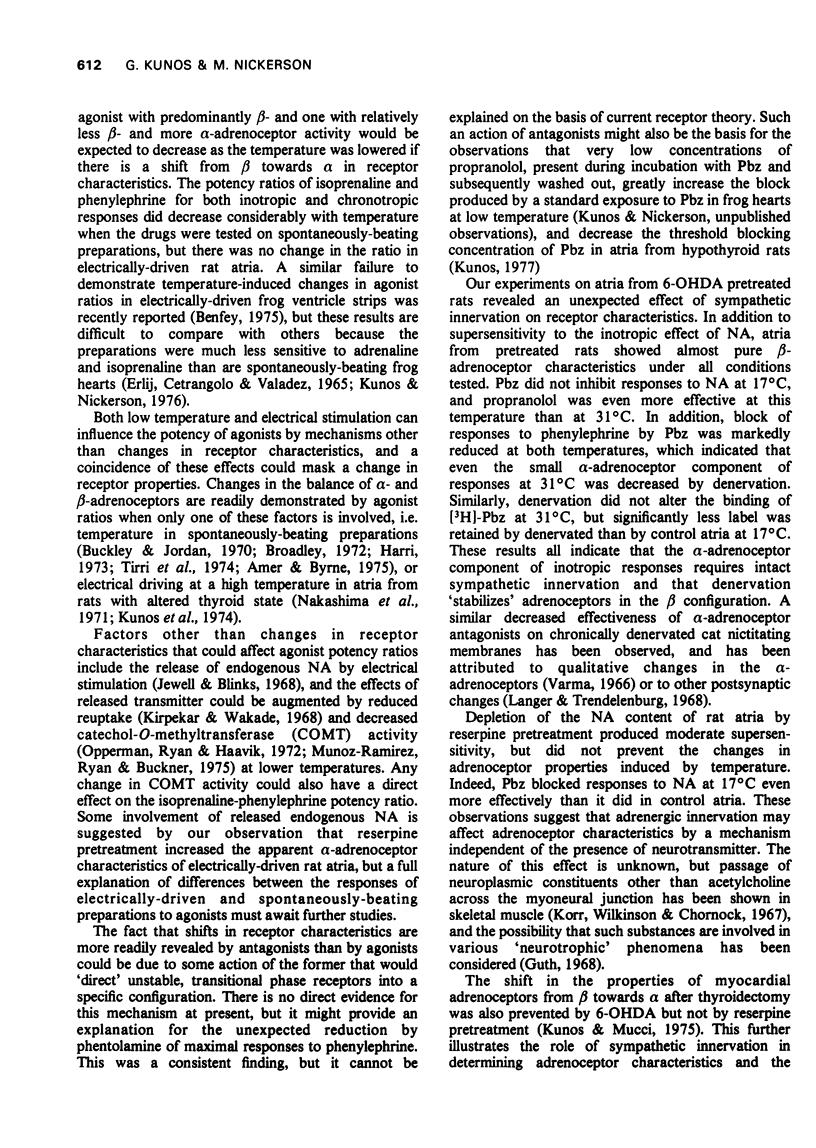
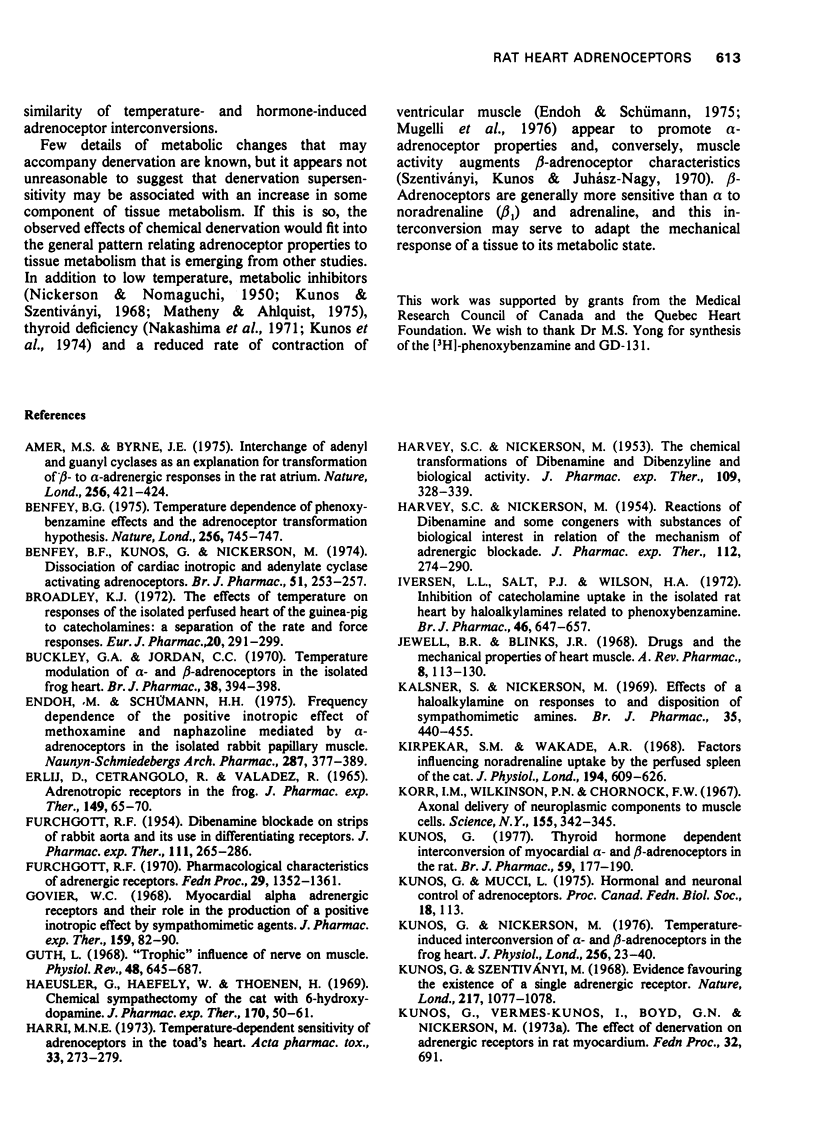
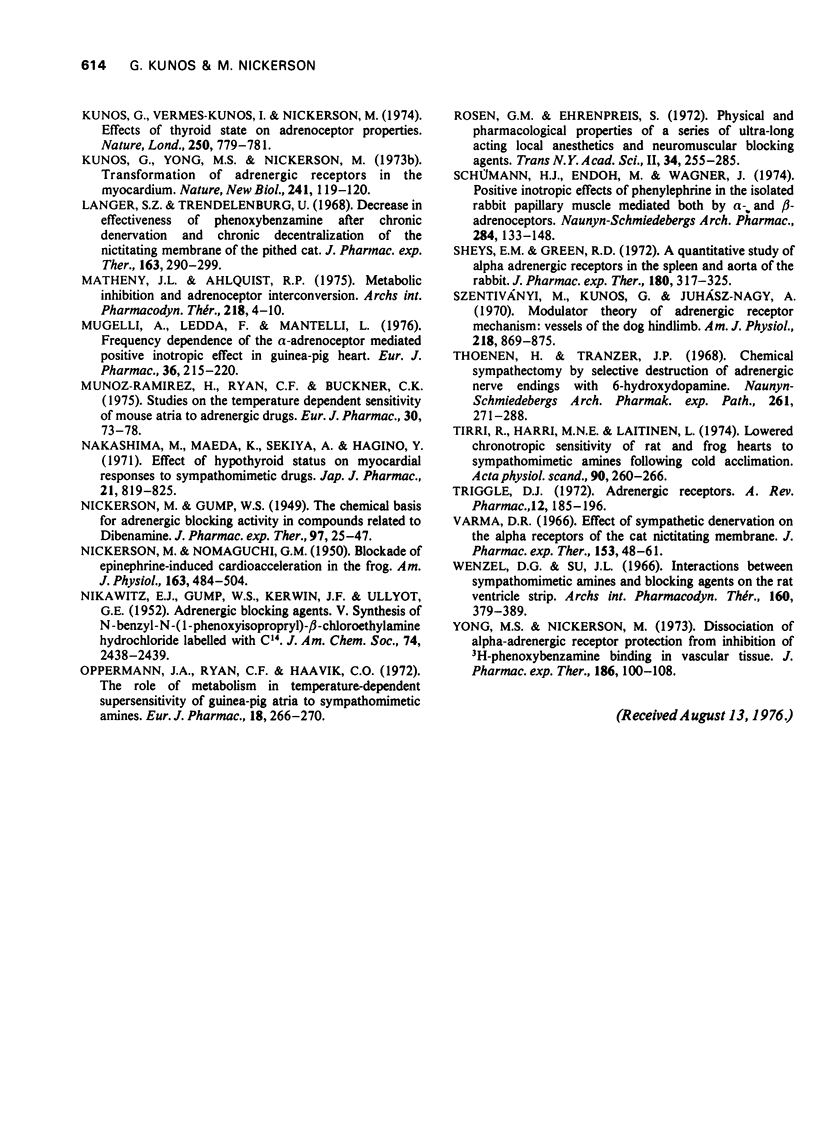
Selected References
These references are in PubMed. This may not be the complete list of references from this article.
- Amer M. S., Byrne J. E. Interchange of adenyl and guanyl cyclases as an explanation for transformation of Beta- to alpha-adrenergic responses in the rat atrium. Nature. 1975 Jul 31;256(5516):421–424. doi: 10.1038/256421a0. [DOI] [PubMed] [Google Scholar]
- Benfey B. G., Kunos G., Nickerson M. Dissociation of cardiac inotropic and adenylate cyclast activating adrenoceptors. Br J Pharmacol. 1974 Jun;51(2):253–257. doi: 10.1111/j.1476-5381.1974.tb09655.x. [DOI] [PMC free article] [PubMed] [Google Scholar]
- Benfey B. G. Temperature dependence of phenoxybenzamine effects and the adrenoceptor transformation hypothesis. Nature. 1975 Aug 28;256(5520):745–747. doi: 10.1038/256745a0. [DOI] [PubMed] [Google Scholar]
- Broadley K. J. The effects of temperature on responses of the isolated perfused heart of the guinea pig to catecholamines: a separation of the rate and force responses. Eur J Pharmacol. 1972 Dec;20(3):291–299. doi: 10.1016/0014-2999(72)90189-6. [DOI] [PubMed] [Google Scholar]
- Buckley G. A., Jordan C. C. Temperature modulation of alpha- and beta-adrenoceptors in the isolated frog heart. Br J Pharmacol. 1970 Feb;38(2):394–398. [PMC free article] [PubMed] [Google Scholar]
- ERLIJ D., CETRANGOLO R., VALADEZ R. ADRENOTROPIC RECEPTORS IN THE FROG. J Pharmacol Exp Ther. 1965 Jul;149:65–70. [PubMed] [Google Scholar]
- Endoh M., Schümann H. J. Frequency-dependence of the positive inotropic effect of methoxamine and naphazoline mediated by alpha-Adrenoceptors in the isolated rabbit papillary muscle. Naunyn Schmiedebergs Arch Pharmacol. 1975;287(4):377–389. doi: 10.1007/BF00500039. [DOI] [PubMed] [Google Scholar]
- FURCHGOTT R. F. Dibenamine blockade in strips of rabbit aorta and its use in differentiating receptors. J Pharmacol Exp Ther. 1954 Jul;111(3):265–284. [PubMed] [Google Scholar]
- Furchgott R. F. Pharmacological characteristics of adrenergic receptors. Fed Proc. 1970 Jul-Aug;29(4):1352–1361. [PubMed] [Google Scholar]
- Govier W. C. Myocardial alpha adrenergic receptors and their role in the production of a positive inotropic effect by sympathomimetic agents. J Pharmacol Exp Ther. 1968 Jan;159(1):82–90. [PubMed] [Google Scholar]
- Guth L. "Trophic" influences of nerve on muscle. Physiol Rev. 1968 Oct;48(4):645–687. doi: 10.1152/physrev.1968.48.4.645. [DOI] [PubMed] [Google Scholar]
- HARVEY S. C., NICKERSON M. Reactions of dibenamine and some congeners with substances of biological interest in relation to the mechanism of adrenergic blockade. J Pharmacol Exp Ther. 1954 Nov;112(3):274–290. [PubMed] [Google Scholar]
- HARVEY S. C., NICKERSON M. The chemical transformations of dibenamine and dibenzyline and biological activity. J Pharmacol Exp Ther. 1953 Nov;109(3):328–339. [PubMed] [Google Scholar]
- Haeusler G., Haefely W., Thoenen H. Chemical sympathectomy of the cat with 6-hydroxydopamine. J Pharmacol Exp Ther. 1969 Nov;170(1):50–61. [PubMed] [Google Scholar]
- Harri M. N. Temperature-dependent sensitivity of adrenoreceptors in the toad's heart. Acta Pharmacol Toxicol (Copenh) 1973;33(4):273–279. doi: 10.1111/j.1600-0773.1973.tb01527.x. [DOI] [PubMed] [Google Scholar]
- Iversen L. L., Salt P. J., Wilson H. A. Inhibition of catecholamine uptake in the isolated rat heart by haloalkylamines related to phenoxybenzamine. Br J Pharmacol. 1972 Dec;46(4):647–657. doi: 10.1111/j.1476-5381.1972.tb06890.x. [DOI] [PMC free article] [PubMed] [Google Scholar]
- Jewell B. R., Blinks J. R. Drugs and the mechanical properties of heart muscle. Annu Rev Pharmacol. 1968;8:113–130. doi: 10.1146/annurev.pa.08.040168.000553. [DOI] [PubMed] [Google Scholar]
- Kalsner S., Nickerson M. Effects of a haloalkylamine on responses to and disposition of sympathomimetic amines. Br J Pharmacol. 1969 Mar;35(3):440–455. doi: 10.1111/j.1476-5381.1969.tb08285.x. [DOI] [PMC free article] [PubMed] [Google Scholar]
- Kirpekar S. M., Wakade A. R. Factors influencing noradrenaline uptake by the perfused spleen of the cat. J Physiol. 1968 Feb;194(3):609–626. doi: 10.1113/jphysiol.1968.sp008428. [DOI] [PMC free article] [PubMed] [Google Scholar]
- Korr I. M., Wilkinson P. N., Chornock F. W. Axonal delivery of neuroplasmic components to muscle cells. Science. 1967 Jan 20;155(3760):342–345. doi: 10.1126/science.155.3760.342. [DOI] [PubMed] [Google Scholar]
- Kunos G., Nickerson M. Temperature-induced interconversion of alpha-and beta-adrenoceptors in the frog heart. J Physiol. 1976 Mar;256(1):23–40. doi: 10.1113/jphysiol.1976.sp011309. [DOI] [PMC free article] [PubMed] [Google Scholar]
- Kunos G., Szentivanyi M. Evidence favouring the existence of a single adrenergic receptor. Nature. 1968 Mar 16;217(5133):1077–1078. doi: 10.1038/2171077a0. [DOI] [PubMed] [Google Scholar]
- Kunos G. Thyroid hormone-dependent interconversion of myocardial alpha- and beta-adrenoceptors in the rat. Br J Pharmacol. 1977 Jan;59(1):177–189. doi: 10.1111/j.1476-5381.1977.tb06992.x. [DOI] [PMC free article] [PubMed] [Google Scholar]
- Kunos G., Vermes-Kunos I., Nickerson M. Effects of thyroid state on adrenoceptor properties. Nature. 1974 Aug 30;250(5469):779–781. doi: 10.1038/250779a0. [DOI] [PubMed] [Google Scholar]
- Kunos G., Yong M. S., Nickerson M. Transformation of adrenergic receptors in the myocardium. Nat New Biol. 1973 Jan 24;241(108):119–120. doi: 10.1038/newbio241119a0. [DOI] [PubMed] [Google Scholar]
- Langer S. Z., Trendelenburg U. Decrease in effectiveness of phenoxybenzamine after chronic denervation and chronic decentralization of the nictitating membrane of the pithed cat. J Pharmacol Exp Ther. 1968 Oct;163(2):290–299. [PubMed] [Google Scholar]
- Matheny J. L., Ahlquist R. P. Metabolic inhibition and adrenoceptor interconversion. Arch Int Pharmacodyn Ther. 1975 Nov;218(1):4–10. [PubMed] [Google Scholar]
- Mugelli A., Ledda F., Mantelli L. Frequency dependence of the alpha-adrenoceptor-mediated positive inotropic effect in guinea pig heart. Eur J Pharmacol. 1976 Mar;36(1):215–220. doi: 10.1016/0014-2999(76)90274-0. [DOI] [PubMed] [Google Scholar]
- Muñoz-Ramírez H., Ryan C. F., Buckner C. K. Studies on the temperature-dependent sensitivity of mouse atria to adrenergic drugs. Eur J Pharmacol. 1975 Jan;30(1):73–78. doi: 10.1016/0014-2999(75)90205-8. [DOI] [PubMed] [Google Scholar]
- NICKERSON M., NOMAGUCHI G. M. Blockade of epinephrine-induced cardio-acceleration in the frog. Am J Physiol. 1950 Dec;163(3):484–504. doi: 10.1152/ajplegacy.1950.163.3.484. [DOI] [PubMed] [Google Scholar]
- Nakashima M., Maeda K., Sekiya A., Hagino Y. Effect of hypothyroid status on myocardial responses to sympathomimetic drugs. Jpn J Pharmacol. 1971 Dec;21(6):819–825. doi: 10.1254/jjp.21.819. [DOI] [PubMed] [Google Scholar]
- Oppermann J. A., Ryan C. F., Haavik C. O. The role of metabolism in temperature-dependent supersensitivity of guinea-pig atria to sympathomimetic amines. Eur J Pharmacol. 1972 May;18(2):266–270. doi: 10.1016/0014-2999(72)90252-x. [DOI] [PubMed] [Google Scholar]
- Rosen G. M., Ehrenpreis S. Physical and pharmacological properties of a series of ultra-long-acting local anesthetics and neuromuscular blocking agents. Trans N Y Acad Sci. 1972 Mar;34(3):255–285. doi: 10.1111/j.2164-0947.1972.tb02680.x. [DOI] [PubMed] [Google Scholar]
- Schümann H. J., Endo M., Wagner J. Positive inotropic effects of phenylephrine in the isolated rabbit papillary muscle mediated both by alpha- and beta-adrenoceptors. Naunyn Schmiedebergs Arch Pharmacol. 1974;284(2):133–148. doi: 10.1007/BF00501118. [DOI] [PubMed] [Google Scholar]
- Sheys E. M., Green R. D. A quantitative study of alpha adrenergic receptors in the spleen and aorta of the rabbit. J Pharmacol Exp Ther. 1972 Feb;180(2):317–325. [PubMed] [Google Scholar]
- Szentiványi M., Kunos G., Juhász-Nagy A. Modulator theory of adrenergic receptor mechanism: vessels of the dog hindlimb. Am J Physiol. 1970 Mar;218(3):869–875. doi: 10.1152/ajplegacy.1970.218.3.869. [DOI] [PubMed] [Google Scholar]
- Thoenen H., Tranzer J. P. Chemical sympathectomy by selective destruction of adrenergic nerve endings with 6-Hydroxydopamine. Naunyn Schmiedebergs Arch Exp Pathol Pharmakol. 1968;261(3):271–288. doi: 10.1007/BF00536990. [DOI] [PubMed] [Google Scholar]
- Tirri R., Harri M. N., Laitinen L. Lowered chronotropic sensitivity of rat and frog hearts to sympathomimetic amines following cold acclimation. Acta Physiol Scand. 1974 Jan;90(1):260–266. doi: 10.1111/j.1748-1716.1974.tb05585.x. [DOI] [PubMed] [Google Scholar]
- Triggle D. J. Adrenergic receptors. Annu Rev Pharmacol. 1972;12:185–196. doi: 10.1146/annurev.pa.12.040172.001153. [DOI] [PubMed] [Google Scholar]
- Varma D. R. Effect of sympathetic denervation on the alpha receptors of the cat nictitating membrane. J Pharmacol Exp Ther. 1966 Jul;153(1):48–61. [PubMed] [Google Scholar]
- Wenzel D. G., Su J. L. Interactions between sympathomimetic amines and blocking agents on the rat ventricle strip. Arch Int Pharmacodyn Ther. 1966 Apr;160(2):379–389. [PubMed] [Google Scholar]
- Yong M. S., Nickerson M. Dissociation of alpha adrenergic receptor protection from inhibition of H-phenoxybenlamine binding in vascular tissue. J Pharmacol Exp Ther. 1973 Jul;186(1):100–108. [PubMed] [Google Scholar]


